Geothermal heating systems of a country house: features of making it yourself
We know that geothermy is the heat of the Earth, and the term “geothermal” is often associated with volcanoes and geysers in our country. In Russia, geothermal energy is used mainly on an industrial scale, for example, there are Far Eastern power plants operating on the basis of the heat of our planet.
Many people are sure that making home geothermal heating at home is something from the realm of fantasy. Is not it? But this is completely wrong! With the development of modern technology, the domestic use of “green energy” has become quite real.
We will talk about the principles of alternative heating, its advantages and disadvantages, comparable with traditional heating systems. You will also learn about the location of the heat exchanger and how to mount geothermal heating yourself.
The content of the article:
- A few historical facts
- The real advantages and disadvantages
- About sources of geothermal heating
- The principle of operation of such heating
- Two types of heat exchanger arrangement
- Immersion of a horizontal heat exchanger in a pond
- Do it yourself: what and how
- Costs and payback prospects
- Conclusions and useful video on the topic
A few historical facts
When the oil crisis erupted in the 70s of the last century, a burning need arose in the West alternative energy sources. It was at this time that the first geothermal heating systems began to be created.
Today, they are widely used in the United States, Canada, and Western European countries.
For example, in Sweden, the Baltic Sea water is actively used, the temperature of which is + 4 ° С. In Germany, the introduction of geothermal heating systems is even sponsored at the state level.
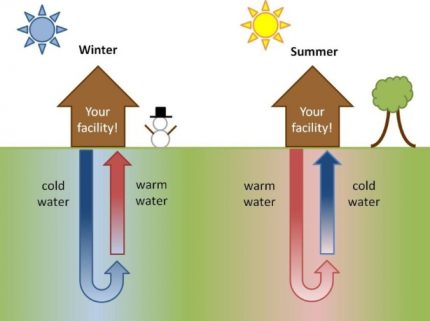
In Russia, Pauzhetskaya, Verkhne-Mutnovskaya, Okeanskaya and other geothermal power plants operate. But the facts of using the energy of the Earth in our private sector are very few.
The real advantages and disadvantages
If in Russia geothermal heating of the private sector is relatively small, does this mean that the idea is not worth the cost of its implementation? Maybe you should not deal with this issue? It turned out that this is not so.
Using a geothermal heating system is a profitable solution. There are several reasons for this. Among them is the quick installation of equipment that is able to work for a long time without any interruptions.
If you use not water, but high-quality antifreeze in the heating system, it will not freeze and its wear will be minimal.
We list other advantages of this type of heating.
- The procedure for burning fuel is excluded. We are creating an absolutely fireproof system, which, during its operation, will not be able to cause any damage to housing. In addition, a number of other aspects related to the presence of fuel are excluded: now there is no need to look for a place for its storage, to engage in its preparation or delivery.
- Significant economic benefits. During the operation of the system, no additional investments are required. Annual heating is provided by the forces of nature, which we do not buy. Of course, during the operation of the heat pump, electrical energy is expended, but at the same time, the volume of energy produced significantly exceeds the consumption.
- Environmental factor. Geothermal heating of a private country house is an environmentally friendly solution. The absence of a combustion process excludes the entry of combustion products into the atmosphere. If many people realize this, and such a heat supply system will receive due widespread distribution, the negative impact of people on nature will be greatly reduced.
- Compact system. You do not have to organize a separate boiler room in your house. All that will be needed is a heat pump, which can be placed, for example, in the basement. The most voluminous contour of the system will be located underground or under water, on the surface of your site you will not see it.
- Multifunctionality. The system can work both for heating in the cold season, and for cooling during the summer heat. That is, in fact, it will replace for you not only a heater, but also an air conditioner.
- Acoustic comfort. The heat pump runs almost silently.
The choice of a geothermal heating system is economically viable, despite the fact that you have to spend money on the purchase and installation of equipment.
By the way, the disadvantage of the system is precisely the costs that you have to go to install the system and prepare it for work. It will be necessary to buy the pump itself and some materials, to complete the installation of the external manifold and internal circuit.
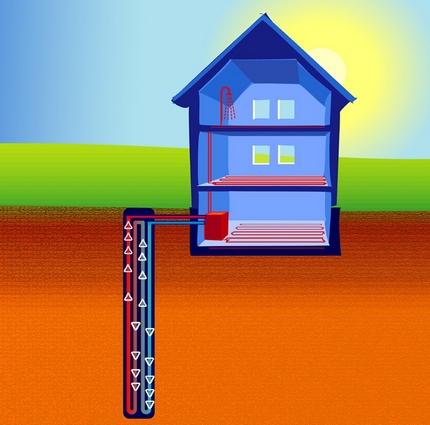
However, these costs pay off in just the first few years of operation. Subsequent use of a collector laid in the ground or immersed in water can save significant costs.
In addition, the installation process itself is not so complicated as to invite outside specialists for its implementation. If you do not drill, then everything else can be done independently.
It should be noted that some craftsmen, in an effort to save money, learned to collect geothermal own heat pump.
About sources of geothermal heating
For geothermal heating, you can use the following sources of terrestrial thermal energy:
- high temperature;
- low temperature.
High-temperature sources include, for example, thermal springs. You can use them, but the scope of their application is limited to the actual location of such sources.
If this type of energy is actively used in Iceland, in Russia thermal waters are far from settlements. As much as possible, they are concentrated in Kamchatka, where underground water is used as a coolant and delivered to hot water supply systems.
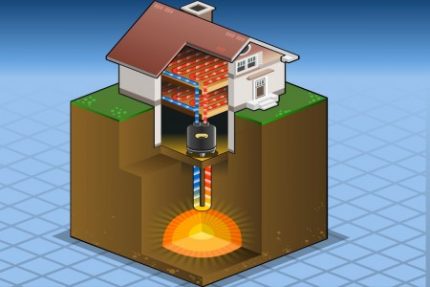
But for the use of low-temperature sources, we have all the necessary prerequisites. For this purpose, the surrounding air masses, earth or water are suitable.
To extract the necessary energy using a heat pump. With its help, the procedure of converting the ambient temperature into thermal energy of not only heating, but also the hot water supply of a private home ownership takes place.
The principle of operation of such heating
If you are familiar with how it works air conditioning or refrigerator, then the similarity of these processes with the principle of functioning of geothermal heating is obvious. The basis of the system is a heat pump, which is included in two circuits - external and internal.
To organize a traditional heating system in any house, it is necessary to mount pipes in it for transporting the coolant, and radiators, when heated, the heat will enter the premises. In our case, pipes and radiators are also needed. They form the internal circuit of the system. Can be added to the circuit warm floor.
The external circuit looks much larger than the internal one, although its dimensions can only be estimated during the planning and installation period. During operation, it is invisible because it is underground or under water. Ordinary water or ethylene glycol-based antifreeze circulates inside this circuit, which is much preferable.
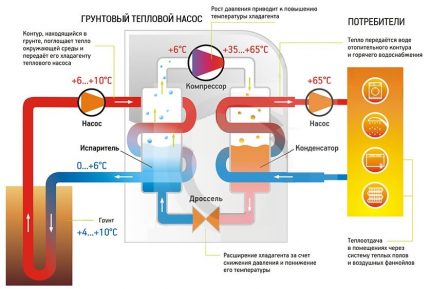
Thus, the key element that revitalizes the entire system is the heat pump. If your house has an ordinary washing machine, then know: this pump will occupy approximately the same area.
To work, he needs electricity, but, consuming only 1 kW, he provides the generation of 4-5 kW of heat. And this is not a miracle, since the source of “additional” energy is known - this is the environment.
Two types of heat exchanger arrangement
There are two options for heating a private house using low-temperature energy elements of the environment. The basis of the system in all three cases is a geothermal pump.
The internal circuit remains unchanged for any heating method, and the main difference is the location of the external circuit.
Geothermal heating happens with a heat exchanger located:
- upright - located in wells that reveal or do not open the aquifer;
- horizontally - heat exchangers of systems are placed in a pit or open pond in the form of a kind of coil.
Each of the types of heating given here is characterized by its features, disadvantages and advantages.
If you intend to create such a heating system with your own hands, you will be interested to learn more about each type.
Option 1. Vertical placement of an external collector
This type of heating is based on an interesting natural phenomenon: at a depth of 50-100 m or more from its surface, the earth has the same and constant temperature of 10-12 ° C year-round.
To be able to use this earth energy, it is necessary drill vertical wells. The technology is almost the same as preparing a water source.
In order to maximize the preservation of the landscape, you can drill several pipes from the same starting point, but from different angles.
The external circuit of the system will be mounted directly in these wells. This will effectively take away its heat from the earth. Of course, this method can hardly be called simple and low-budget.
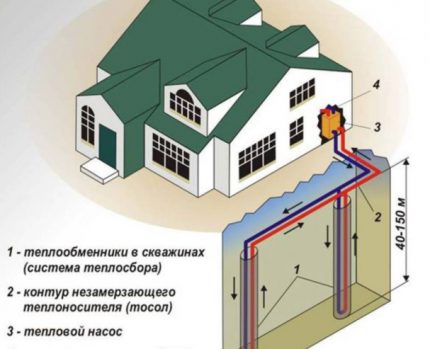
It is relevant in the case when the territory adjacent to the house is already equipped, and violation of its landscape is inappropriate. The depth of well drilling can reach from 50 to 200 meters.
The specific parameters of the well depend on the geological situation on the site and the parameters of the future structure. The service life of this design is approximately 100 years.
To install a vertical version of a system with a heat exchanger that extracts underground water energy, it will be necessary to drill two aquifers.
Of one of them, called debit, with the help of a pump, water is drawn, which after heat transfer merges into the second, receiving generation.
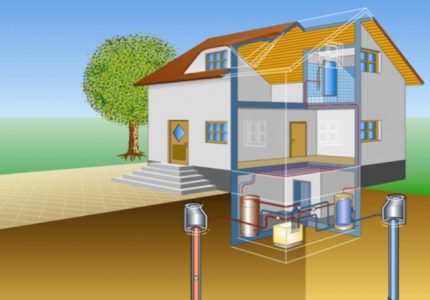
Option # 2. Horizontal arrangement of soil collector
To lay the external contour with a horizontal type of heating, you need to know how deep the ground freezes in your area.
Pipes are laid below the freezing level in pre-prepared trenches, while capturing a rather large space: to heat a house with an area of 200-250 square meters. m, you need to use about 600 square meters. m of heat exchanger. That is six hundred parts.
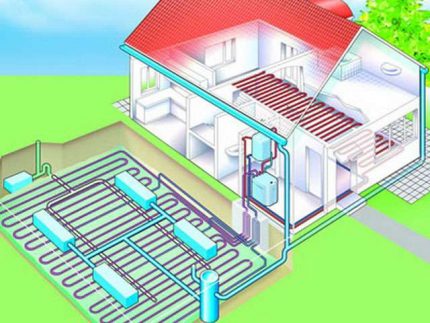
It is clear that under such conditions, the volume of earthwork will be significant.In addition, you need to consider in terms of the location of trees and other vegetation on the site, so as not to freeze them. For example, it is impossible to place the collector pipes closer than one and a half meters from the trees.
This installation method is used, as a rule, in those cases when the site is just being mastered for construction. All calculations and plans for the construction of the cottage, the organization of its heating and the planning of the land are best done simultaneously.
Immersion of a horizontal heat exchanger in a pond
This method requires a special arrangement of home ownership - at a distance of about 100 m from a reservoir of sufficient depth. In addition, the specified reservoir should not freeze to the bottom, where the external circuit of the system will be located. And for this, the area of the reservoir cannot be less than 200 square meters. m
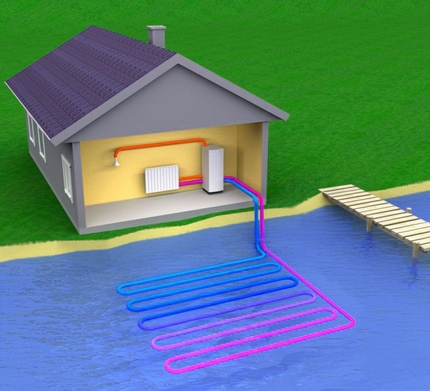
The obvious advantage of this method is the lack of mandatory labor-intensive excavation, although you still have to tinker with the underwater location of the collector. And a special permit for such work will also be needed.
However, a geothermal installation using water energy is still the most economical.
Do it yourself: what and how
If you already install your own geothermal heating, then the external circuit is still better to buy ready-made. Of course, we only consider ways of horizontal arrangement of the external heat exchanger: under the surface of the soil or under water.
It is much more difficult to mount a vertical borehole collector yourself if you do not have the equipment and drilling skills.
The heat pump is not too large equipment. In your house, it does not take up much space. After all, in size it is comparable, for example, with a conventional solid fuel boiler. Connecting the internal contour of your home to it is a simple task.
In fact, everything is done exactly the same as when organizing and heating wiring using traditional heat sources. The main difficulty is the arrangement of the external circuit.
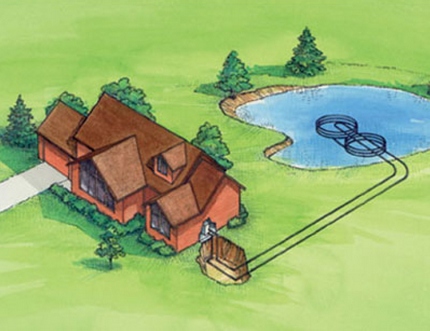
The best option would be to use a body of water if there is one at a distance of no more than 100 m. It is necessary that its area exceed 200 sq. m, and depth - 3 m (average freezing parameter). If this reservoir does not belong to you, then a problem may be obtaining permission to use it.
If the reservoir is a pond that is in your possession, then the matter is simplified. Water from the pond can be temporarily pumped out. Then the work on its bottom can be done easily: it will be necessary to lay the pipes in a spiral, fixing them in this position.
Earthwork will be needed only for digging a trench, which will be needed to connect the external circuit to the heat pump.
After all work has been completed, the pond can be filled again with water. In the next few years, an external heat exchanger should work properly and not cause trouble to its owner.
If you have at your disposal a land plot on which you only have to build housing and grow a garden, it makes sense to plan a horizontal soil-type heat exchanger.
For this, a preliminary calculation of the area of the future collector should be made, based on the parameters that are already indicated above: 250-300 sq. m of collector per 100 square meters. m of heated area of the house.
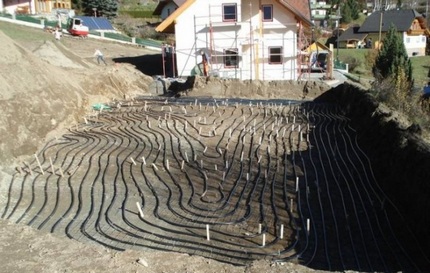
The trenches in which to lay the pipes of the circuit must be dug below the level of freezing of the soil.
And even better - just remove the soil to the depth of its freezing, lay the pipes, and then return the soil to its place. The work is time-consuming, difficult, but with a great desire and determination, you can complete it.
Costs and payback prospects
The costs of equipment and its installation during the construction of geothermal heating depend on the capacity of the unit and on the manufacturer.
Everyone chooses a manufacturer, guided by their own considerations and information about the reputation and reliability of a particular brand. But the power depends on the area of the room to be serviced.
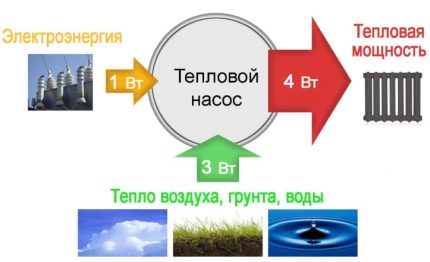
If we take into account precisely the power, then the cost of heat pumps varies in the following ranges:
- 4-5 kW - 3000-7000 conventional units;
- 5-10 kW - 4000-8000 conventional units;
- 10-15 kW - 5000-10000 conventional units.
If we add to this amount the costs that are needed to complete the installation work (20-40%), then we will get an amount that for many seems completely unrealistic.
But all these costs will pay off in quite reasonable terms. In the future, you will have to pay only insignificant expenses for electricity necessary for the pump to work. And it's all!
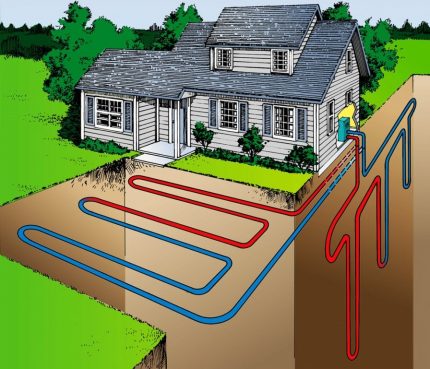
As practice shows, geothermal heating is especially beneficial for homes with a total heated area of 150 square meters. m. For five to eight years, all the costs of arranging heating systems in these houses fully pay off.
If geothermal heating is not particularly in demand among owners of private houses, then the efficiency of the gel systems has already been appreciated by residents of the southern regions. Technology solar heating facilities simple enough, and its cost-effectiveness and practicality is confirmed by many years of experience in use by Western countries and our compatriots.
Additional information on alternative energy sources is provided in this article.
Conclusions and useful video on the topic
If it’s easier for you to perceive visual information, then this video will allow you to see for yourself how the geothermal system functions, as well as learn more about who and why this type of heating is beneficial.
We invite you to watch a short video in which the owner of a horizontal subsoil collector will tell about his impressions of its operation.In addition, by watching this video, you will learn about the running costs associated with operating a geothermal heating system.
Each owner of a private house chooses for himself whether to buy the services of resource-supplying organizations or to rely only on himself. In doing so, he is guided by a list of considerations.
The goal that we set for ourselves is not to push you to a ready conclusion, but to share information on options for solving the problem you are facing.
Have something to supplement, or have questions about the geothermal heating of a private house? You can leave comments on the publication. The contact form is located in the lower block.

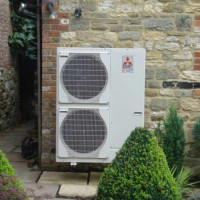 How to make a heat pump for heating a house with your own hands: the principle of operation and assembly scheme
How to make a heat pump for heating a house with your own hands: the principle of operation and assembly scheme 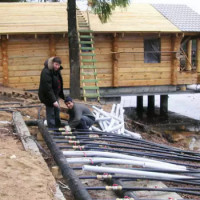 DIY geothermal heat pump for home heating: device, design, self-assembly
DIY geothermal heat pump for home heating: device, design, self-assembly 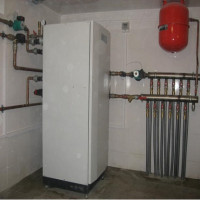 How to make a heat pump with your own hands from an old refrigerator: drawings, instructions and assembly tips
How to make a heat pump with your own hands from an old refrigerator: drawings, instructions and assembly tips 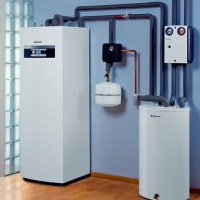 Water-water heat pump: device, principle of operation, rules for arranging heating on its basis
Water-water heat pump: device, principle of operation, rules for arranging heating on its basis 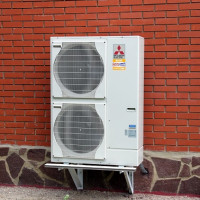 Air-to-air heat pump: principle of operation, device, selection and calculations
Air-to-air heat pump: principle of operation, device, selection and calculations 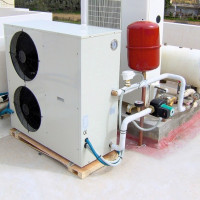 How to make an air-water heat pump: device diagrams and self-assembly
How to make an air-water heat pump: device diagrams and self-assembly  How much does it cost to connect gas to a private house: the price of organizing gas supply
How much does it cost to connect gas to a private house: the price of organizing gas supply  The best washing machines with dryer: model rating and customer tips
The best washing machines with dryer: model rating and customer tips  What is the color temperature of light and the nuances of choosing the temperature of the lamps to suit your needs
What is the color temperature of light and the nuances of choosing the temperature of the lamps to suit your needs  Replacement of a geyser in an apartment: replacement paperwork + basic norms and requirements
Replacement of a geyser in an apartment: replacement paperwork + basic norms and requirements
Geothermal heat sources are already in full use in Europe to reduce the use of traditional fuels and, thereby, save the ecological situation. It is often read that states provide all kinds of support to such projects, but in Russia, for now, one can only dream of it. Only enthusiasts deal with this issue.
As long as the price of geothermal heating is so high, it will not develop here.
I am constantly interested in this topic. We would have such a system in every private house if the equipment and work on its construction were not so expensive. Costs will pay off very slowly, within 20-30 years, this is more an investment in the future, rather than a quick effect. Therefore, many states reasonably financially support such events among the population. I'm now interested in the cost of the unit and its power consumption.
Yeah! And do you think the payback of the main gas is less than 20-30 years? I will greatly disappoint you! Plus, an annual service contract, which simply does not exist, is annually raised by prices and more! So think about it.
A man became interested in geothermal heating, and you are talking about gas. The main gas will not have a payback, since it is not a priori a free alternative. You are confusing people with such statements and questions.
Now for the equipment for geothermal heating, its maintenance and warranty. Installation companies provide a warranty of 15-20 years.
At the moment, we can say that for heating a house of 100 m2 and providing it with hot water, you will need to pay about 6.5-7 thousand euros. Not such a big price for their own almost free heating and hot water. This allows you to reach a payback period of five years. I will also attach a visual diagram of the principle of the geothermal heating of the house.